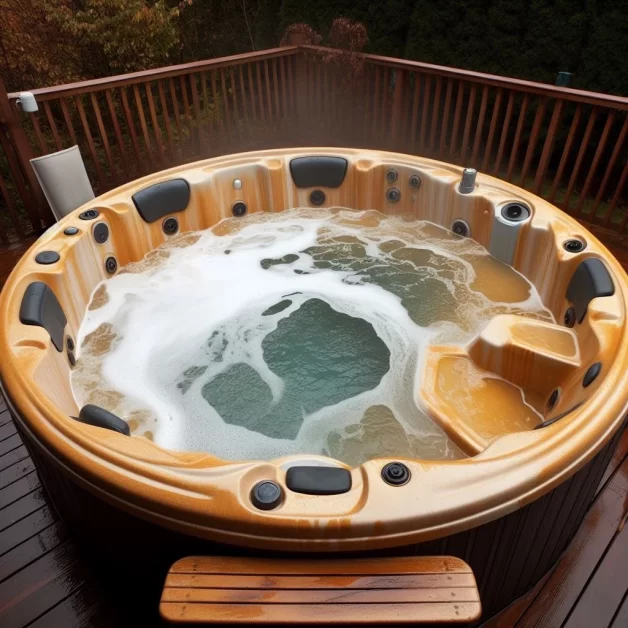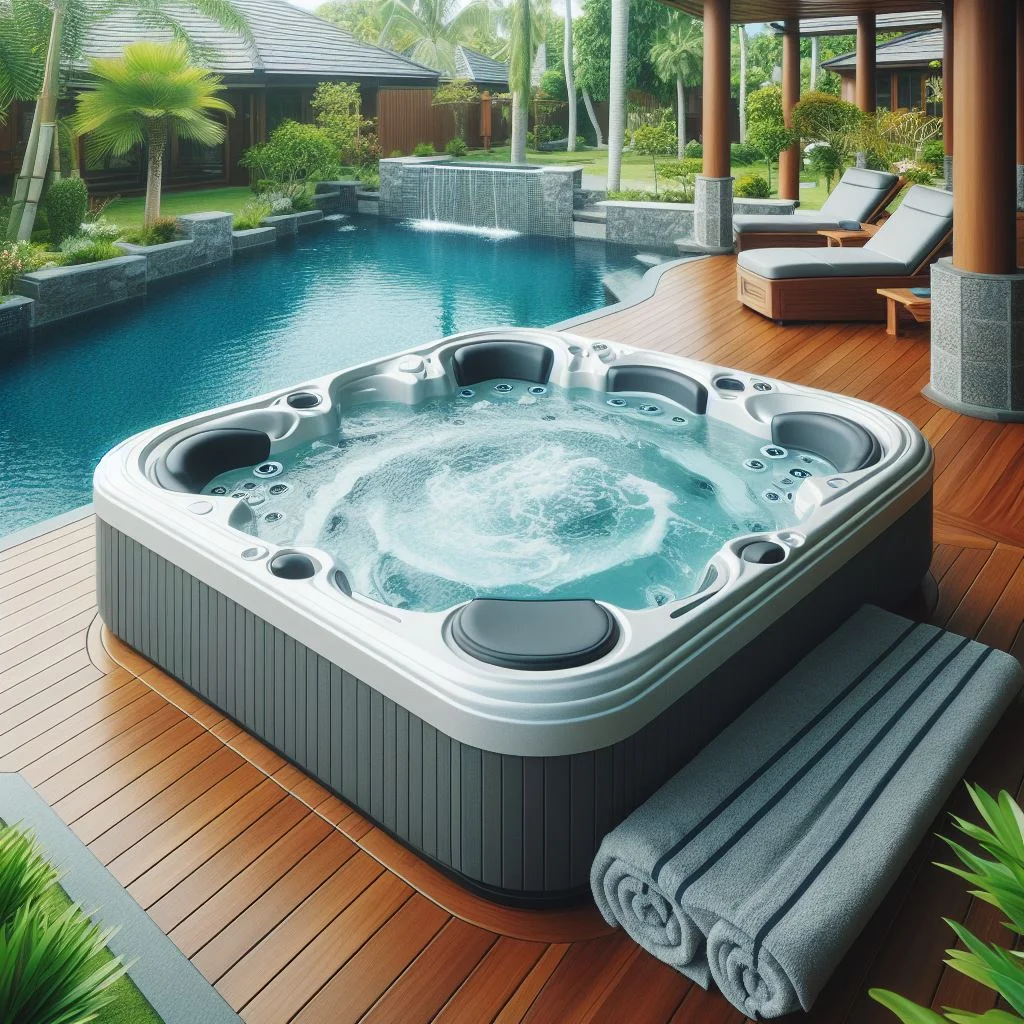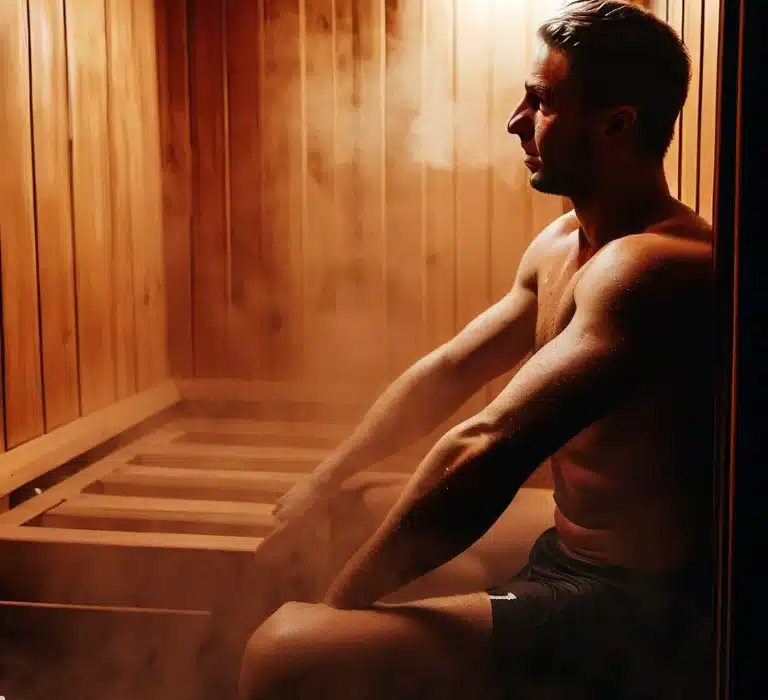Understanding Discoloration in Hot Tub Water
Unravel the depths of hot tub maintenance as we delve into the mystery behind water discoloration. Explore practical solutions and gain insights into the importance of water quality testing for a clear and enjoyable soak every time.
Imagine stepping into your hot tub, expecting a moment of relaxation, only to find murky green water or an unsettling brown tint.
Discolored hot tub water is not only unappealing but can signal underlying issues that compromise the enjoyment and potential health of your soak.
This guide aims to demystify the causes of discoloration, provide solutions, and empower you to maintain crystal-clear hot tub water consistently.
Discoloration Demystified: Causes and Clues
Green Water
- The Culprit: Algae Algae are microscopic plant-like organisms that thrive in warm, nutrient-rich environments – making your hot tub a potential haven. Insufficient sanitizer levels and excess nutrients like phosphates and nitrates from sources like fertilizers or decaying leaves create an environment conducive to algae blooms.
- Visual Clues: Telltale Signs of Algae
- Green Tint: The water takes on a greenish hue, which may start subtly and intensify over time.
- Slimy Surfaces: The hot tub walls and floor may feel slimy to the touch, indicating algae buildup.
- Visible Algae Clusters: You might see green, brown, or even black clumps of algae floating in the water or clinging to surfaces.
Brown/Red Water: Rusty Repercussions
The Cause: Unwanted Metals
- Discolored water with a brown, red, or even orange tinge often points to the presence of dissolved metals in your hot tub water. The primary culprit is usually iron, but copper and manganese can also be problematic. These metals can enter your hot tub through your source water, especially well water, or corrosion of pipes and fittings.
- The real trouble arises when these metals come into contact with the sanitizer (typically chlorine or bromine) in your hot tub. This exposure triggers a chemical reaction called oxidation, which turns the dissolved metals into rust-like particles. These particles then stain your hot tub water and surfaces, creating an unsightly brown or red hue.
Visual Clues: A Sign of Something Rusty
- If your hot tub water has taken on a brownish or reddish tint, here are some visual clues to confirm the culprit is likely metals:
Color Variations: The water might not be a uniform brown or red. It could have shades of orange or even a slightly cloudy appearance.Surface Stains: Look for reddish-brown stains on the walls, floor, and fittings of your hot tub. These stains are a telltale sign of metal oxidation.Metallic Scent: In some cases, you might detect a faint metallic odor in the water, further indicating the presence of dissolved metals.
Yellow/Cloudy Water: Unveiling the Cloud Cover
- Causes: A Cloud of Culprits
- Organic Matter Overload: Body oils, lotions, sweat, cosmetics, hair products, and even residues from swimsuits can all contribute to organic matter buildup. This creates a breeding ground for bacteria and leads to a cloudy, potentially yellowish appearance.
- Biofilm Buildup: Biofilms are sticky, complex communities of bacteria that cling to surfaces like your hot tub’s walls, floor, and even the plumbing system. As biofilms mature, they can release particles into the water, causing persistent cloudiness.
- Water Chemistry Imbalance: Low sanitizer levels, high pH, or insufficient alkalinity create a welcoming environment for bacteria and other microorganisms. This can result in cloudy water and an increased risk of biofilm formation.
- Filtration Failure: A poorly maintained filter can’t effectively remove small particles from the water. Inadequate filtration time also allows contaminants to accumulate, leading to cloudiness.
- Visual Clues & Differentiating Causes
- Appearance: Cloudiness from organic matter often has a dull, hazy quality. Mineral-related cloudiness can be more ‘sparkly’ or crystalline.
- Tint: Organic matter can contribute to a slight yellowish tint in the water.
- Odor: A strong chlorine smell often accompanies high organic waste, while cloudiness without the smell might indicate mineral imbalances.
- Oily Feel: Excessive organic contaminants can sometimes leave a slightly oily or slick feeling on the skin.
Health Considerations
While not typically dangerous, unaddressed cloudiness presents some concerns:
- Reduced Sanitizer Efficiency: Contaminants can bind to sanitizers like chlorine, making them less effective at killing bacteria and viruses.
- Breeding Ground for Bacteria: Biofilm, in particular, provides a protected environment for harmful bacteria to grow, potentially leading to skin irritation or even hot tub folliculitis.

Restoring Crystal Clarity: Solutions and Strategies
The Power of Shock Treatment
- What is Shock Treatment? Also known as “superchlorinating,” shocking adds a concentrated dose of sanitizer (chlorine-based or non-chlorine) to your hot tub water. This process serves two key purposes:
- Oxidation: Shock breaks down organic waste compounds introduced by bathers (body oils, sweat, etc.). These compounds often lead to cloudiness and odors and reduce the sanitizer’s effectiveness.
- Sanitizing: Chlorine shock raises free chlorine levels temporarily to eliminate bacteria and other microorganisms lurking in the water.
- When to Shock:
- Routine Maintenance: A weekly shock treatment helps prevent water clarity issues and sanitizer depletion.
- Heavy Use: Shock the hot tub after parties or periods of high battery load.
- Addressing Problems: Cloudy or green water often signals the need for shock treatment to restore clarity.
- Choosing the Right Shock
- Chlorine Shock: The most common option, effective in raising sanitizer levels and oxidizing most contaminants.
- Non-Chlorine Shock: A good alternative if chlorine levels are already high, these oxidizers tackle organic matter without significantly impacting sanitizer levels.
Specialized Products
- Algaecides: Your Algae Defense
- The Purpose: Algaecides supplement your sanitizer to inhibit and prevent algae growth.
- Prevention vs. Treatment: Routine use of a preventative algaecide helps keep algae at bay. If facing a bloom, a stronger, treatment-strength algaecide may be necessary.
- Clarifiers: Filtration’s Finest Hour
- How They Work: Clarifiers contain agents that bind tiny particles together, allowing your filter to trap them more effectively.
- When to Use: Clarifiers are helpful when your water is cloudy or dull, lacking a ‘sparkle’, even if filtration seems adequate.
- Metal Sequestrants: Fighting Stains
- The Mission: Metal sequestrants bind dissolved metals, preventing them from oxidizing and staining your hot tub surfaces.
[wps_alert type=”note”]Important Note: If you have high metal levels in your source water, a sequestrant helps minimize issues. However, professional consultation or a pre-filter for your water supply might be necessary for a long-term solution.[/wps_alert]
For more about Hot Tub Water Care Beyond Saltwater Systems.
The Importance of Filtration (and Filter Maintenance)
- Types of Filters:
- Cartridge Filters: The most common type, featuring pleated fabric that traps contaminants.
- Sand and DE Filters: While less common in residential hot tubs, these use sand or diatomaceous earth to catch particles.
- How Filtration Works
- Mechanical Removal: Filters physically trap particles and debris as water is circulated through them. Think of them as fine sieves for your hot tub.
- Maintenance Matters
- Cleaning: Regular rinsing and chemical cleaning of filters are crucial to keep them working effectively. Clogged filters lead to cloudy water and put unnecessary strain on your pump.
- Replacement: Cartridge filters should be replaced according to the manufacturer’s recommendation, typically every 12-24 months, depending on use.
Prevention is Key: Proactive Maintenance Tips
Consistent Water Testing and Balancing
- The Foundation of Clear Water: Water chemistry is the cornerstone of a clean and inviting hot tub. Key parameters like pH, alkalinity, and sanitizer levels work together:
- pH: Measures how acidic or basic your water is, impacting how effectively your sanitizer works and influencing the comfort of your soak.
- Alkalinity: This acts as a buffer, preventing swings in pH that compromise the water balance.
- Sanitizer: Your primary defense against bacteria and viruses, chlorine and bromine are the most common options.
- Frequency of Testing: Regular testing is crucial. Aim to test your hot tub water 2-3 times per week (more often with heavy use). Testing both before and after soaking can help you track how bather load affects the chemistry.
- Types of Test Kits:
- Test Strips: Convenient and quick, they offer a decent snapshot of your water chemistry.
- Liquid Test Kits: Typically more accurate than strips, especially if color differentiation is difficult for you.
- Record Keeping: Log your test results in a notebook or app. This helps you identify patterns, such as consistent drops in alkalinity, and address issues before they become major problems.
- Benefits Beyond Clarity: Proper water balance isn’t just about looks! It protects your hot tub’s surfaces, plumbing, and equipment from corrosion and extends the life of your investment.
Protecting Your Water
- Source Matters: The quality of the water you fill your hot tub with significantly impacts long-term water clarity and balance.
- Tap Water: Municipal water is generally safe, but it can contain varying levels of minerals that might require adjustment.
- Well Water: Well water often needs more careful attention, as it’s more likely to have high levels of metals (iron, copper, etc.) that cause discoloration. Testing your well water source is essential.
- Pre-filters: If your source water has a high mineral content, a pre-filter attached to your hose can improve clarity and reduce problems over time.
- Hot Tub Covers: Your First Line of Defense
- Debris Shield: Covers prevent leaves, insects, and other debris from entering the water, making it easier to maintain.
- Evaporation Control: By minimizing evaporation, covers help your water chemistry stay consistent and reduce the need for frequent topping up.
- Energy Saver: Covers retain heat, reducing energy costs compared to leaving your hot tub uncovered.
- Showering Before Entering
- A simple step – Big Impact: A quick rinse removes lotions, body oils, hair products, and even traces of laundry detergent from your swimsuit. These substances cloud the water, interfere with sanitizers, and even lead to unpleasant foam.
Hot Tub Water Care Guide
We’re here to help.
Closing Arguments:
Discoloration doesn’t have to ruin your hot tub experience. Now that you understand the causes, you have the power to maintain crystal-clear water with simple solutions. Consistent water testing and preventative steps like showering before entering and using a cover will keep your hot tub looking pristine.
Enjoy your Hot Tub Patio oasis, knowing every soak offers worry-free relaxation and inviting waters!
Common Queries:
What are the most effective hot tub water discoloration solutions for addressing common issues like algae growth and mineral buildup? 1. Algae: Shock treatment, algaecides, and thorough cleaning if severe. 2. Minerals: Metal sequestrants to prevent stains and pre-filters for source water issues.
How can hot tub owners implement proactive measures for preventing water contamination and maintaining pristine water quality?
- Consistent Testing and Balancing: Regularly monitor pH, alkalinity, and sanitizer levels and adjust as needed.
- Source Water Care: Test water and use pre-filters for metal-rich sources.
- Hot Tub Cover: Reduces debris and maintains chemistry.
- Pre-Soak Rinse: Remove lotions, etc., before entering the hot tub.
What are some expert-recommended hot tub maintenance tips for ensuring optimal performance and longevity of your relaxation oasis?
- Regular Filter Cleaning/Replacement: Follow the manufacturer’s guidelines.
- Drain and Refill: Fresh water every 3-4 months prevents buildup.
- Consider Source Water: Issues with tap or well water can impact clarity despite your efforts.
How do environmental factors contribute to hot tub water discoloration, and what preventative steps can be taken to mitigate their effects?
1. Sunlight: Encourages algae growth; a cover helps, and strategic hot tub placement offers shade. 2. Debris: Leaves, pollen, etc., can cause cloudiness; a cover is crucial, and a skimmer net is helpful.
Are there any DIY methods for preventing water contamination in hot tubs, or is professional assistance always necessary for effective maintenance?
- DIY is Effective: Most maintenance is manageable with the right products and knowledge.
- Professional Assistance: Useful for severe water balance issues, equipment problems, or if you lack time for DIY care.












